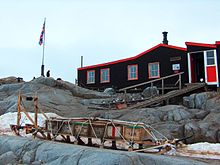Operation Tabarin
The Operation Tabarin was a small British expedition of the Second World War , which was launched in 1943 to the Antarctic to establish permanently occupied stations.
Reasons for the expedition
There are several reasons for Tabarin surgery . Before the start of the war, German aircraft had dropped markings with swastikas over Queen Maud Land as part of the German Antarctic Expedition 1938/39 in order to officially claim the territory. In 1943, the crew of HMS Carnarvon Castle removed Argentine flags from Deception Island . The Foreign Office was also concerned about possible post-war US activity in the region. One reason for the expedition was to establish sound British claims to various uninhabited islands and areas of Antarctica , which was reinforced by Argentine sympathies with the Third Reich .
Second, it was necessary to prevent the enemy from setting up shelter in Antarctica. It was known that Germany used remote islands as meeting points and as protection for warships, submarines, and supply units. In 1941 there was also fear of a possible Japanese attack on the Falkland Islands , whether as a base or to hand them over to Argentina and thus gain a political advantage for the Axis powers . Deception Island in the British South Shetland Islands had a sheltered harbor with a former Norwegian whaling station . In 1941 the British had taken the precautionary measure on board the HMS Queen of Bermuda to destroy the coal depots and oil tanks there in order to prevent possible use by the Germans.
It has also been suggested that the operation may have been in part a disinformation operation, nominally to uncover suspected German replenishment operations - information that was actually already known through the Enigma's code deciphering . The real motives are still kept secret in government files.
The expedition
On Saturday, January 29, 1944, a fourteen-man strong expedition team under Lieutenant James Marr left the Falkland Islands with two ships, the HMS William Scoresby (a anti-mine trawler ) and the HMS Fitzroy . Marr had accompanied the British explorer Ernest Shackleton on his Antarctic expeditions in the 1920s.
During February bases were established near the abandoned Norwegian whaling station on Deception Island (February 3) and at Port Lockroy (February 11) on Wiencke Island west of Grahamland . Another station was set up in Hope Bay on February 13, 1944 , after an attempt to unload goods on February 7, 1944 failed.
British territorial claims were further reinforced by the issue of postage stamps .
reaction
The decision to start Operation Tabarin was obviously not a political decision. Prime Minister Winston Churchill was out of the country and a memo Churchill prepared in response to the announcement in the press indicates he was unaware of the decision. In the memo, he expressed concern that the operation could strain relations with the United States during the preparations for Operation Overlord . A response from the Foreign Office stated that the operation was started not because of the lack of recognition of British territorial claims by the US, but to secure British claims against Argentina and Chile.
post war period
After the end of the Second World War, the bases of Operation Tabarin were handed over to civilians of the Falkland Islands Dependencies Survey (FIDS), later renamed the British Antarctic Survey (BAS).
The dispute over the ownership of the South Shetland Islands has been put on hold under the Antarctic Treaty of December 1, 1959. There are British, Chilean and Argentine demands, but the United States and Russia also reserve the right to make demands at a later date. The suspension of the demand is a central point for the execution of the scientific work.
See also
literature
- Ashley Jackson: The British Empire and the Second World War . Hambledon Continuum, London 2006, ISBN 1-85285-417-0 , pp. 73-75.
Web links
- History of the BAS (English)
- Scouting Milestones via James Marr . Archived from the original on June 3, 2012. Retrieved October 21, 2013. (English)
